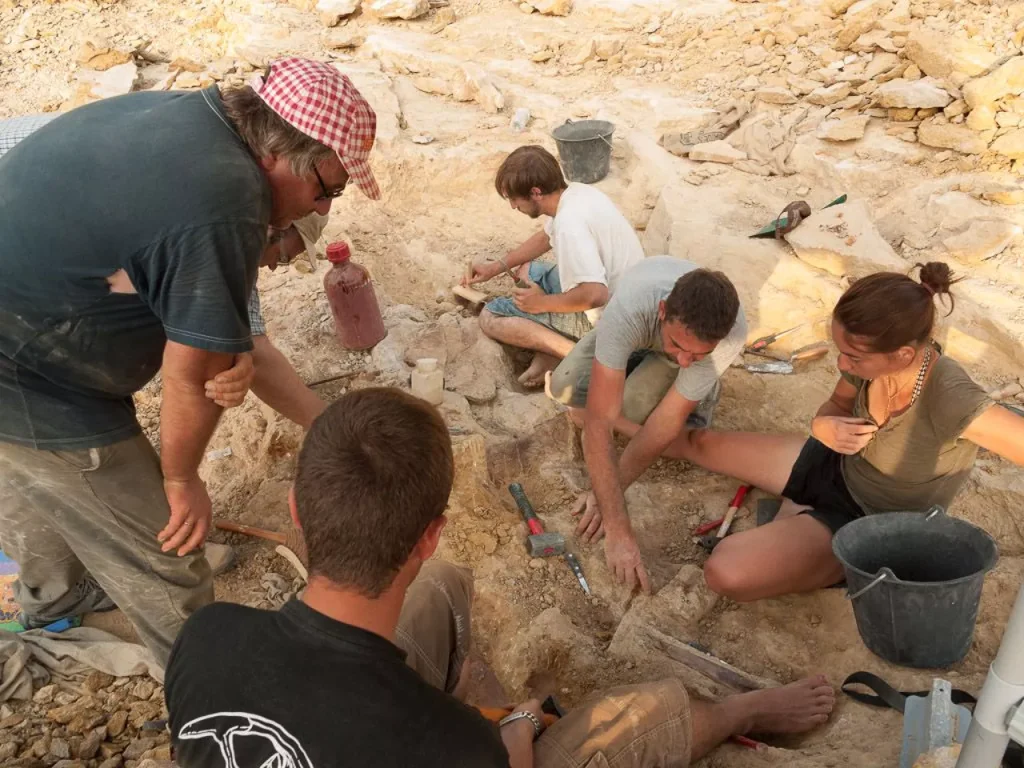Did the peloton digest the second rest day well? We sure hope so. After a day without geology science for you to dig your teeth in, we continue for the last week! Last year we had a dinosaur with big feet. This year we introduce a dinosaur with funky teeth. The riders slice through the heart of France’s dinosaur paradise. It’s a true dinosaur hotspot, featuring one of its most cheerful Cretaceous members! Smile, you are a dinosaur!

After the fireworks in the Pyrenees, and a well-deserved rest-day, the peloton starts today with an – on paper – smooth 187 km flat stroll from Gruissan to Nîmes. This region in the southern part of France is also known as the ‘dinosaur paradise’ of the country. Many important and new dinosaur species dating back to the Late Cretaceous were found in this area. To be more time precise to the Late Campanian. This period is named after the wonderful Champagne region in northern France. We also look at the early Maastrichtian. That bears the name of the lovely Dutch town of Maastricht. We are talking roughly between 75 and 70 million years ago. Let’s investigate the short history of dinosaurs and what makes today’s stage a dinosaur paradise.
Le Tour d’Océan
As a loyal follower of GeoTDF, you know by now that France was largely covered by a shallow subtropical sea in this time period. In the southern part we find an inland system. You find today’s stage at the yellow star. If we were to travel back to the Late Campanian and Maastrichtian we would see a lush coastal landscape full of life. There are palm trees, fish, crabs, crocodiles, turtles, pterosaurs (flying reptiles), and bien sûr: dinosaurs! The Dinosauria museum in Espéraza has a great collection of French dinosaur fossils. It’s not far from the start of today’s race.

Short history lesson
This year it is exactly 200 years ago that scientists named the first dinosaur. Hurray! On 20th February 1824, William Buckland, a professor at Oxford University, gave a historic lecture before a group of assembled scientists of the Geological Society of London. He had studied some fossils from Oxfordshire (UK). His findings included a lower jaw with a peculiar protruding tooth with serrations. He suspected that these belonged to the same animal. He named it Megalosaurus, meaning “giant lizard.” Buckland showed the fossils to Georges Cuvier, who was one of the greatest French anatomists from France. With his help Buckland was able to publish his findings in a scientific article in 1824.
Over the next 15 years, more large fossil reptile bones were recovered in England and reviewed by the British anatomist Richard Owen. In 1842 Owen decided that these fossils were so different from any known reptiles that they deserved to be classified as a completely new group of giant fossil reptiles. He called them Dinosauria – “terrible, or fearfully great, reptiles”. Prior to 1842 nobody had heard of dinosaurs. The rest is, in essence, history.
French dinosaurs
In France, Georges Cuvier already described the first dinosaurs in 1808. However, this went unnoticed for a long time because Cuvier considered a set of fossil vertebrae from the Late Jurassic of Normandy to be belonging to a giant extinct crocodile. Much later these vertebrae were named ‘Streptospondylus’ meaning ‘reversed vertebra’. It was not until 2001 before these were recognized as a meat-eating (theropod) dinosaur.
Besides Cuvier, another big name in French paleontology was Philippe Matheron. From the 1840s onwards, he was the first one that did prominent discoveries in the Provence region in southeastern France. It is where we race today. His work includes the description of the first dinosaur eggs, a sauropod dinosaur species and a whole new family of plant-eating dinosaurs called the rhabdodontids.

This rhabdodontids are so-called iguanodontid ornithopod dinosaurs. In other words, they are related to the much more well-known Iguanodon. This was one of the earliest dinosaurs discovered by scientists. You can see the Iguanodon prominently in the dinosaur gallery of the Royal Belgian Institute of Natural Sciences in Brussels. It comes from a famous discovery in a coal mine in southern Belgium. The rhabdodontids, however, do not yet have this type of stardom. They certainly deserve a further introduction using a new finding!
Bonjour, new dinosaur
One of the latest members to join the French dinosaur family is a rhabdodontid named Matheronodon provincialis. The name honours Philippe Matheron. It means ‘tooth of Matheron’ with the reference to the Provence region. Professor Pascal Godefroit of the Royal Belgian Institute of Natural Sciences in Brussels, and his team, described this new species of plant-eating dinosaurs in 2017. Read more here.
In a thin sandstone layer in Velaux-La Bastide Neuve, the team of Belgian and French paleontologists found a fragmented lower jaw and some isolated teeth. This site is close to today’s finish line and a real dinosaur paradise. Since these remains were so different compared to previously described rhabdodontid material, the authors erected a new genus and species. They estimated the animal to be approximately five meters long. That’s about half the size of its older and more illustrious cousin Iguanodon.

Big foot eh tooth
One aspect that makes Matheronodon provincialis so unique is that it had extremely enlarged teeth. They were up to six centimeters long and five centimeters wide. Also, in sharp contrast to Iguanodon that yielded 25 curved teeth in the lower jaw, Matheronodon only had 8 teeth in the lower jaw. This shows that this new species, even though it was living in a much later time period in the Cretaceous, was actually much more of a primitive cousin of Iguanodon. Finally, the massive teeth of Matheronodon were also clearly marked with many ridges. It most likely could use these as a pair of self-sharpening serrated scissors.

These evolutionary adaptations in the denture of Matheronodon and the rhabdodontids show that they evolved in a different direction than another group of large herbivores during the Late Cretaceous. Think of the duck-billed dinosaurs or hadrosaurs such as Parasaurolophus and Edmontosaurus. Hadrosaurs had sophisticated dental ‘batteries’ formed by hundreds of very little teeth with which they could crush and grind pine trees like conifers. In contrast, Matheronodon and the other rhabdodontids probably ate leaves of palm trees. These were abundant in the European island systems at that time. With their scissor-like teeth they had to cut rather than crush the fibre-rich leaves, before they could swallow them.
Knife between your teeth
In today’s race the riders hopefully don’t have to chew too much on tough fibers. Will this afternoon see some lonely escapees dig their teeth into a surprise attack in this windy corner of France? Or will the sprinter teams ride with a knife between their teeth to make sure that at the finish line their leader will smile like a Matheronodon?
NB: Blogs in other languages than English are all auto-translated. Our writers are not responsible for any language and spelling mistakes.




